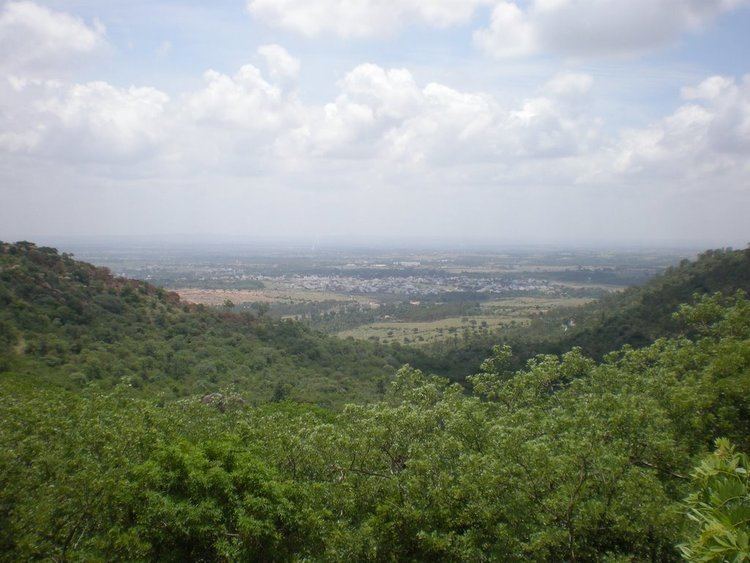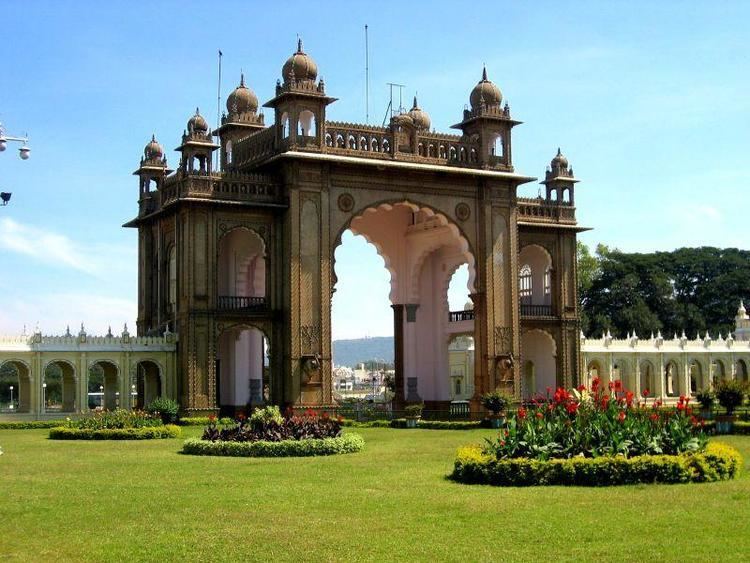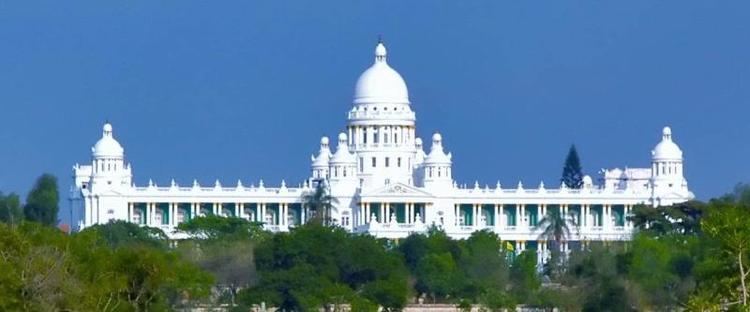Country Population 755,379 (2001) Language spoken Area 128 km2 | State District Mysore Mayor Rajeshwari M C | |
Points of interest Mysore Palace, Mysore Zoo, Brindavan Gardens, Karanji Lake, Jaganmohan Palace Colleges and Universities University of Mysore, Karnataka State Open University, Sri Jayachamarajendra College of Engineering, National Institute of Engineering, JSS Medical College | ||
Mysore , also known as Mysuru, is the third largest city in the state of Karnataka, India, which served as the capital city of Mysore Princely Kingdom (Kingdom of Mysore) for nearly six centuries, from 1399 until 1947. Located at the base of the Chamundi Hills about 146 km (91 mi) southwest of the state capital Bangalore, it is spread across an area of 128.42 km2 (50 sq mi) .According to the provisional results of the 2011 national census of India, the population of Mysore is 887,446. Mysore City Corporation is responsible for the civic administration of the city, which is also the headquarters of the Mysore district and the Mysore division.
Contents
- Map of Mysore
- Best places to visit in mysore mysore travel guide
- Places to visit in mysore
- History
- Economy
- Culture
- Geography
- Tourism
- Chef preparing a delicious dish at a restaurant mysore karnataka
- References
Map of Mysore
The Kingdom of Mysore was ruled by the Wodeyar dynasty, except for a brief period in the late 18th century when Hyder Ali and Tipu Sultan were in power. Patrons of art and culture, the Wodeyars contributed significantly to the cultural growth of the city. The cultural ambience and achievements of Mysore earned it the sobriquet Cultural capital of South Karnataka. Mysore is noted for its palaces, including the Mysore Palace, and for the festivities that take place during the Dasara festival when the city receives a large number of tourists. It lends its name to the Mysore style of painting, the sweet dish Mysore Pak, the Mysore Peta (a traditional silk turban) and the garment known as the Mysore silk saree. Tourism is the major industry, while information technology has emerged as a major employer alongside the traditional industries. Mysore depends mainly on rail and bus transport for inter-city connections. It also has an Airport serving the city, also known as Mandakalli Airport. The city was the location of the first private radio station in India. Mysore houses Mysore University, which has produced several notable authors, particularly in the field of Kannada literature. Cricket is the most popular sport in the city, however it has many other sport facilities.
Best places to visit in mysore mysore travel guide
Places to visit in mysore
History

The site where Mysore Palace now stands was occupied by a village named Puragere at the beginning of the 16th century. The Mahishuru Fort was constructed in 1524 by Chamaraja Wodeyar III (1513–1553), who passed on the dominion of Puragere to his son Chamaraja Wodeyar IV (1572–1576). Since the 16th century, the name of Mahishuru has commonly been used to denote the city. The Mysore Kingdom, governed by the Wodeyar family, initially served as a vassal state of the Vijayanagara Empire. With the decline of the Vijayanagara Empire after the Battle of Talikota in 1565, the Mysore Kingdom gradually achieved independence,and by the time of King Narasaraja Wodeyar (1637) it had become a sovereign state. Seringapatam (modern-day Srirangapatna), near Mysore, was the capital of the kingdom from 1610. The 17th century saw a steady expansion of its territory and, under Narasaraja Wodeyar I and Chikka Devaraja Wodeyar, the kingdom annexed large expanses of what is now southern Karnataka and parts of Tamil Nadu, to become a powerful state in the southern Deccan.
The kingdom reached the height of its military power and dominion in the latter half of the 18th century under the de facto rulers Hyder Ali and his son Tipu Sultan. The latter demolished parts of Mysore to remove legacies of the Wodeyar dynasty. During this time, Mysore kingdom came into conflict with the Marathas, the British and the Nizam of Golconda, leading to the four Anglo-Mysore wars, success in the first two of which was followed by defeat in the third and fourth. After Tipu Sultans death in the Fourth Anglo-Mysore War in 1799, the capital of the kingdom was moved back to Mysore from Seringapatam, and the kingdom was distributed by the British to their allies of the Fourth Mysore war. The landlocked interior of the previous Mysore Kingdom was turned into a princely state under the suzerainty of the British Crown. The former Wodeyar rulers were reinstated as puppet monarchs, now styled Maharajas. The British administration was assisted locally by Diwan (chief minister) Purnaiah. Purnaiah is credited with improving Mysores public works. Mysore lost its status as the administrative centre of the kingdom in 1831, when the British commissioner moved the capital to Bangalore. It regained that status in 1881 and remained the capital of the Princely State of Mysore within the British Indian Empire until India became independent in 1947.
The Mysore municipality was established in 1888 and the city was divided into eight wards. In 1897 an outbreak of bubonic plague killed nearly half of the population of the city. With the establishment of the City Improvement Trust Board (CITB) in 1903, Mysore became one of the first cities in Asia to undertake planned development of the city. Public demonstrations and meetings were held there during the Quit India movement and other phases of the Indian independence movement.
After Indian independence, Mysore city remained as part of the Mysore State, now known as Karnataka. Jayachamarajendra Wodeyar, then king of Mysore, was allowed to retain his titles and was nominated as the Rajapramukh (appointed governor) of the state. He died in September 1974 and was cremated in Mysore city. Over the years, Mysore became well known as a centre for tourism; the city remained largely peaceful, except for occasional riots related to the Kaveri river water dispute. Among the events that took place in Mysore and made national headlines were a fire at a television studio that claimed 62 lives in 1989, and the sudden deaths of many animals at the Mysore Zoo.
Economy
Tourism is the major industry in Mysore. The city attracted about 3.15 million tourists in 2010. Mysore has traditionally been home to industries such as weaving, sandalwood carving, bronzework and the production of lime and salt. The planned industrial growth of the city and the state was first envisaged at the Mysore economic conference in 1911. This led to the establishment of industries such as the Mysore Sandalwood Oil Factory in 1917 and the Sri Krishnarajendra Mills in 1920.
Culture
Referred to as the cultural capital of South Karnataka, Mysore is well known for the festivities that take place during the period of Dasara, the state festival of Karnataka. The Dasara festivities, which are celebrated over a ten-day period, were first introduced by King Raja Wodeyar I in 1610. On the ninth day of Dasara, called Mahanavami, the royal sword is worshipped and is taken on a procession of decorated elephants, camels and horses. On the tenth day, called Vijayadashami, the traditional Dasara procession (locally known as Jumboo Savari) is held on the streets of Mysore which usually falls in the month of September or October.. the Idol of the Goddess Chamundeshwari is placed on a golden mantapa on the back of a decorated elephant and taken on a procession, accompanied by tabla, dance groups, music bands, decorated elephants, horses and camels. The procession starts from the Mysore Palace and culminates at a place called Bannimantapa, where the banni tree (Prosopis spicigera) is worshipped. The Dasara festivities culminate on the night of Vijayadashami with a torchlight parade, known locally as Panjina Kavayatthu.

Mysore is called the City of Palaces because of several ornate examples in the city. Among the most notable are Amba Vilas, popularly known as Mysore Palace; Jaganmohana Palace, which also serves as an art gallery; Rajendra Vilas, also known as the summer palace; Lalitha Mahal, which has been converted into a hotel; and Jayalakshmi Vilas. The main palace of Mysore was burned down in 1897, and the present-day structure was built on the same site. Amba Vilas palace exhibits an Indo-Saracenic style of architecture on the outside, but a distinctly Hoysala style in the interior. Even though the Government of Karnataka maintains the Mysore palace, a small portion has been allocated for the erstwhile Royal family to live in. The Jayalakshmi Vilas Mansion was constructed by Sri Chamaraja Wodeyar for his daughter Jayalakshammanni. It is now a museum dedicated to folk culture and artifacts of the royal family.
The Mysore painting style is an offshoot of the Vijayanagar school of painting, and King Raja Wodeyar (1578–1617 CE) is credited with having been its patron. The distinctive feature of these paintings is the gesso work, to which gold foil is applied. Mysore is known for rosewood inlay work; around 4,000 craftsmen were estimated to be involved in this art in 2002. The city lends its name to the Mysore silk saree, a womens garment made with pure silk and gold zari (thread). Mysore Peta, the traditional indigenous turban worn by the erstwhile rulers of Mysore, is worn by men in some traditional ceremonies. A notable local dessert that traces its history to the kitchen in the Mysore palace is Mysore pak.
Mysore is the location of the International Ganjifa Research Centre, which researches the ancient card game Ganjifa and the art associated with it. The Chamarajendra Academy of Visual Arts (CAVA) offers education in visual art forms such as painting, graphics, sculpture, applied art, photography, photojournalism and art history. The Rangayana repertory company performs plays and offers certificate courses in subjects related to theatre. Kannada writers Kuvempu, Gopalakrishna Adiga and U. R. Ananthamurthy were educated in Mysore and served as professors at the Mysore University. R. K. Narayan, a popular English-language novelist and creator of the fictional town of Malgudi, and his cartoonist brother R. K. Laxman spent much of their life in Mysore.
Geography

Mysore is located at 12.30°N 74.65°E? / 12.30; 74.65 and has an average altitude of 770 metres (2,526 ft). It is spread across an area of 128.42 km2 (50 sq mi) at the base of the Chamundi Hills in the southern region of Karnataka. Mysore is the southern-most city of Karnataka, and is a neighboring city of the states of Kerala and Tamil Nadu in the south, flanked by the state cities Mercara, Chamarajanagara, and Mandya. People in and around Mysore extensively use Kannada as medium of language.Mysore has several lakes, such as the Kukkarahalli, the Karanji, and the Lingambudhi lakes. In 2001, total land area usage in Mysore city was 39.9% residential, 16.1% roads, 13.74% parks and open spaces, 13.48% industrial, 8.96% public property, 3.02% commercial, 2.27% agriculture and 2.02 water. The city is located between two rivers: the Kaveri River that flows through the north of the city and the Kabini River, a tributary of the Kaveri, that lies to the south.
Tourism

Mysore is a major tourist destination in its own right and serves as a base for other tourist attractions in the vicinity. The city receives large number of tourists during the 10-day Dasara festival. One of the most visited monuments in India, the Amba Vilas Palace, or Mysore Palace, is the centre of the Dasara festivities. The Jaganmohana Palace, The Sand Sculpture Museum the Jayalakshmi Vilas and the Lalitha Mahal are other palaces in the city. Chamundeshwari Temple, atop the Chamundi Hills, and St. Philomenas Church, Wesleys Cathedral are notable religious places in Mysore.

The Mysore Zoo, established in 1892, the Karanji and Kukkarahalli lakes are popular recreational destinations. Mysore has the Regional Museum of Natural History, the Folk Lore Museum, the Railway Museum and the Oriental Research Institute. The city is a centre for yoga-related health tourism that attracts domestic and foreign visitors, particularly those who, for years, came to study with the late ashtanga yoga guru K. Pattabhi Jois.
A short distance from Mysore city is the Krishnarajasagar Dam and the adjoining Brindavana Gardens, where a musical fountain show is held every evening. Places of historic importance close to Mysore are Srirangapatna, Somanathapura and Talakad. B R Hills, Himavad Gopalaswamy Betta hill and the hill stations of Ooty, Sultan Battery and Madikeri are close to Mysore. Popular destinations for wildlife enthusiasts near Mysore include the Nagarhole National Park, the wildlife sanctuaries at Melkote and B R Hills and the bird sanctuaries at Ranganathittu and Kokrebellur. Bandipur National Park and Mudumalai National Park, which are sanctuaries for gaur, chital, elephants, tigers, Indian leopards and other threatened species, lie between 40 and 60 mi (64 and 97 km) to the south. Other tourist spots near Mysore include the religious locations of Nanjanagud and Bylakuppe and the waterfalls at Shivanasamudra.
